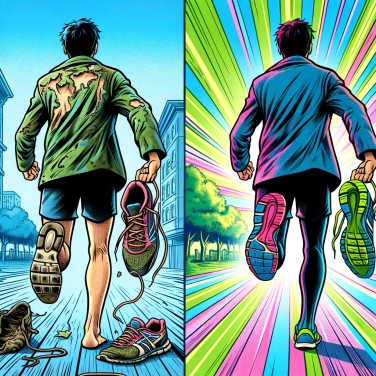It is important to regularly change your running shoes because the cushioning and support of the shoe degrade over time and use, which can increase the risk of injuries and decrease performance.

Your running shoes take a beating with each outing. The outsole (the part that touches the ground) gradually wears down from enduring the friction of kilometers on pavement or trails. The rubber smooths out and loses its grip, especially in areas where the pressure is repeated, such as the heel or the forefoot. Even the upper, which is the part of the shoe that holds your foot in place, eventually deforms and gets damaged. As a result, your stability and support are not the same, which tires your foot even more. It's not just the outer appearance that matters: even if your shoes look fine, the internal materials can deteriorate without you realizing it. Not great for an efficient and secure stride.
When you run regularly, your shoes absorb significant shocks with each stride. The problem is that the cushioning that protects your joints is not eternal. Over time, the foam or gel inside gradually loses its elasticity and impact absorption capacity. As a result, you start to feel the hardness of the ground beneath your feet more and more, even if you don't immediately realize it. This loss of cushioning is deceptive because it happens without warning. Your joints, such as your knees and ankles, thus absorb more violent impacts, gradually increasing their fatigue and the possibility of discomfort or chronic pain. If you want to preserve your joints and run comfortably for as long as possible, regularly check the condition and quality of the cushioning in your shoes.
Running with worn-out shoes puts repeated shocks on your joints (knees, ankles), tendons, and muscles. Without enough cushioning, each stride becomes more aggressive for your body. The result: you easily end up with pains such as tendinitis, knee inflammation (runner's knee), or even stress fractures. Your body constantly compensates for the lack of support from the shoes, leading to imbalances and increasing the risk of injury. In short, regularly changing your shoes is a direct way to protect your body and avoid prolonged periods of forced rest.
When your running shoes start to age, it's impossible to maintain the same efficiency in your stride: you inevitably lose dynamism and responsiveness. This means you expend more energy with each step to maintain the same pace. Gradually, your speed slows down, the sensations become less pleasant, and you find it harder to achieve your athletic goals. Worn-out soles provide less propulsion, less grip, and above all, less comfort. As a result, you quickly become less performant. If you feel heavier or less agile than before, check the condition of your shoes: their wear directly impacts your performance.
Regularly changing running shoes helps prevent the accumulation of bacteria and fungi that thrive in the moisture present after exercise. This therefore limits unpleasant odors and skin infections. Having new shoes regularly also means enjoying a better level of comfort, as the internal foams retain their flexibility and adapt better to your foot. It also reduces uncomfortable friction that can lead to blisters or irritations. In terms of sensations, wearing a fresh pair is simply much more enjoyable and motivating for going for a run.
Even if running shoes still look new on the outside, the materials of the shoes continue to age over time. Therefore, it is advised to replace your shoes at least every 18 to 24 months, even with low usage, to ensure optimal support.
The way you run directly impacts how often you need to replace your shoes. Therefore, a regular long-distance runner will have to change their shoes much more frequently than an occasional runner.
Some experts suggest alternating between two pairs of running shoes so that the materials can rest and regain their original shape, thereby improving their durability and your comfort.
The repeated use of worn-out shoes can gradually alter posture and balance during running, leading to muscular and joint imbalances that increase the risk of long-term injury.
Several indicators may signal that it is time to replace them: noticeable wear on the sole, increased discomfort during activity, unusual pain after running, or visible loss of cushioning.
Yes, absolutely. Your old running shoes can still be useful for light or everyday activities, but it’s best to avoid high-impact sports for which they no longer provide adequate protection.
Yes, owning multiple pairs and alternating them allows each pair to regain its original elasticity and cushioning, thereby optimizing their effectiveness and extending their overall lifespan.
Absolutely. Be sure to clean them regularly with a soft brush, let them air dry (without direct heat sources), and remove the insole after each run to reduce the proliferation of bacteria and moisture.
On average, a pair of running shoes should be replaced after approximately 600 to 800 kilometers. However, this number can vary depending on the runner's weight, the running surface, the type of stride, and the quality of the shoes.

100% of respondents passed this quiz completely!
Question 1/5